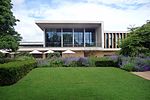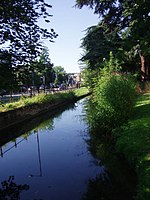Panton Arms

The Panton Arms is a pub in Cambridge, U.K. that is often frequented by scientists from the Engineering and Chemistry Department of the University of Cambridge. It became more widely known in February 2010 when a group of scientists released the Panton Principles — a set of recommendations on how to license and label scientific data that have been made public — that they had drafted in the Panton Arms starting in June 2009. The pub features a "white gingerbread building festooned with hanging baskets of petunias and nestled among rows of Victorian terraced houses" with black wrought iron gates. The atmosphere, service and the food at the pub have generated mixed reviews from online reviewers. It serves beer and there is adequate parking nearby. One reviewer described how it seemed "hidden in a residential area". It is the remaining corner and former tap room of a larger site, originally occupied by a brewery.
Excerpt from the Wikipedia article Panton Arms (License: CC BY-SA 3.0, Authors, Images).Panton Arms
Panton Street, Cambridge Newtown
Geographical coordinates (GPS) Address Nearby Places Show on map
Geographical coordinates (GPS)
| Latitude | Longitude |
|---|---|
| N 52.196 ° | E 0.125 ° |
Address
Panton Street
Panton Street
CB2 1HS Cambridge, Newtown
England, United Kingdom
Open on Google Maps








